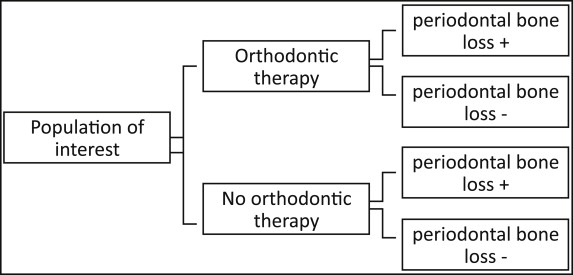The cohort study is the closest design to a clinical trial, since exposed and unexposed patients are followed prospectively, and the outcome is recorded sometime in the future. In cohort studies, the investigator does not intervene; thus, patients are not allocated to treatment groups in either a randomized or a nonrandomized fashion as in clinical trials.
In a study aiming to assess the impact of orthodontic therapy on alveolar bone levels, subjects exposed and unexposed to orthodontic treatment might be followed over time, and an assessment can be made to see whether patients who had orthodontic therapy have diminished alveolar bone levels.
The Figure shows diagrammatically this cohort design. In this example, the groups are included in the study on the basis of exposure or no exposure. Although cohort studies record information on exposures, follow subjects over time, and record outcomes, the information can be collected prospectively or retrospectively. Thus, we have 2 categories of cohort studies: prospective and retrospective.

In a prospective cohort study, the exposure is recorded when the subjects enter the study. An example with orthodontic therapy and periodontitis as a prospective cohort design could be as follows.
- •
Data on exposure (orthodontic therapy or no therapy) are collected now, patients are followed over a number of years, and the incidences of periodontitis are recorded.
The same example in a retrospective cohort approach would be as follows.
- •
Patient files are examined, and information about the exposure is recorded. Since the files contain information on periodontal status over the years, data on the outcome of interest can be extracted from each patient’s file. Therefore, although the direction of the study is prospective, data are collected retrospectively.
It is also possible to conduct a cohort study that is a combination of prospective and retrospective. For example, exposure can be ascertained from past records, and outcome recording is conducted in the future.
Cohort studies measure the incidence (new cases in a time period) of disease in exposed and unexposed groups and permit determination of whether a temporal relationship exists between exposure and outcome. Table I is a 2 × 2 tabulation of a hypothetical cohort study examining the association between orthodontic therapy (exposure) and periodontal bone loss (outcome). Table II shows the calculated risks, risk differences, and risk ratios for a predefined time period. Odds and odd ratios are also shown, just as a reminder of how they relate to risk and risk ratio.



